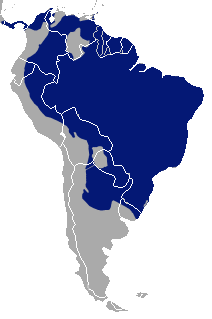Crab-eating raccoon
| Crab-eating raccoon | |
|---|---|
 |
|
| in Reserva de Fauna Carmelo, Uruguay | |
| Scientific classification | |
| Kingdom: | Animalia |
| Phylum: | Chordata |
| Class: | Mammalia |
| Order: | Carnivora |
| Family: | Procyonidae |
| Genus: | Procyon |
| Species: | P. cancrivorus |
| Binomial name | |
|
Procyon cancrivorus (Cuvier, 1798) |
|
| Subspecies | |
|
|
 |
|
| Crab-eating raccoon range | |
The crab-eating raccoon (Procyon cancrivorus) is a species of raccoon native to marshy and jungle areas of Central and South America (including Trinidad and Tobago). It is found from Costa Rica south through most areas of South America east of the Andes down to northern Argentina and Uruguay. That it is called the crab-eating raccoon does not mean that only this species eats crabs, as the common raccoon also seeks and eats crabs where they are available.
The crab-eating raccoon eats crab, lobster, and other crustaceans, but is an omnivore and its diet also includes, for example, small amphibians, turtle eggs, and fruits. It resembles its northern cousin, the common raccoon, in having a bushy ringed tail and "bandit mask" of fur around its eyes. Unlike the common raccoon, the hair on the nape of the neck points towards the head, rather than backward. The crab-eating raccoon also appears to be more adapted to an arboreal lifestyle than the common raccoon, with sharper, narrower claws. It also is better adapted for a diet of hard-shelled food, with most of the cheek teeth being larger than those of the common raccoon, with broader, rounded cusps. Although the crab-eating raccoon can appear smaller and more streamlined than the common raccoon due to its much shorter fur and more gracile build, the crab-eating raccoon is of similar dimensions to the northern species. Head and body length is 41 to 80 cm (16 to 31 in), tail length is 20 to 56 cm (8 to 22 in) and height at the shoulder is about 23 cm (9 in). Weights can range from 2 to 12 kg (4 to 26 lb), though are mostly between 5 and 7 kg (11 and 15 lb). Males are usually larger than the females.
The crab-eating raccoon is solitary and nocturnal, primarily terrestrial but will spend a significant amount of time in trees. It is almost always found near streams, lakes, and rivers. In Panama and Costa Rica, where it is sympatric with the common raccoon, it will be strictly found in inland rivers and streams, while the common raccoon lives in mangrove forests. Less frequently, it will reside in evergreen forests or the plains, but are only rarely found in rainforests. Compared to the common raccoon, which thrives in urban environments and adapts quickly to the presence of humans, the crab-eating raccoon adapts less easily and is much less likely to be found in human environments.
...
Wikipedia

